As winter wears on, the passing of Groundhog Day has many people thinking about the arrival of spring. Even skeptics can’t be faulted for dreading Punxsutawney Phil’s shadow, but I’ve been watching for a different omen. I’ve been awaiting the arrival of the American robin, a traditional harbinger of spring in the United States.
But there’s a hitch. Recently, while gazing out my apartment window, I saw not just one robin but a flock of thirty or more visiting my neighborhood trees. Weirder still, these robins weren’t eating their standard springtime worms, they were noshing on late fruiting berries. Spring has certainly not arrived, so why have the robins?
To learn more about this behavior, I spoke to Elizabeth Howard, Founder and Director of Journey North. Journey North’s American Robin project is tracking robin movements across North America. She pointed out that robins, though they are considered migratory, don’t follow the typical north to south and back migration pattern we tend to associate with other migratory birds.
Robins in Winter
“Robins can withstand very cold temperatures,” Howard explains. “In most places you can see robins in the wintertime. You’ll see them wandering around and yet it’s not considered migration because basically they’re moving in a nomadic way, following the food.”
Many robins, especially those that remain in the northern states and southern Canada, change their diets in winter. Since worms and insects aren’t available, they search out trees that still have fruit.
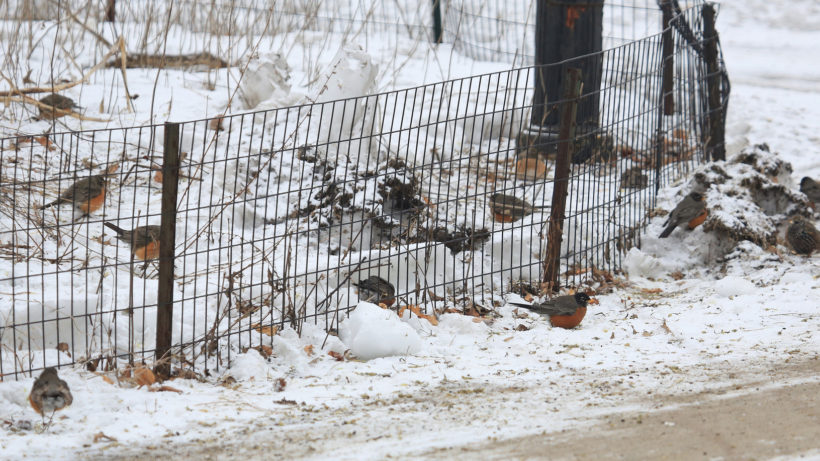
“In the wintertime robins are actually social,” Howard says. “They form flocks — all those eyes and ears are good for watching out for predators. And one of the beauties of flocking is that if one of them finds some food, it can call the rest.”
Even in freezing temperatures, robins can stay warm enough to make staying through the winter worthwhile. Those who remain near their mating grounds will get first dibs on the best nesting territories when spring arrives.
“Sometimes you see them and it’s so cold you think, ‘My goodness they’ll all die.’” Howard says. “It’s amazing, the way they survive winter is they fluff their feathers and get really big. Their internal temperature is 104° F and yet they can be in areas below freezing. That’s how well their feathers insulate them; there can even be a 100-degree difference just through those layers of feathers.”
If you want to observe robins in winter, try putting out water for them. They can survive on their own by eating snow, but birds always welcome a source of unfrozen water for drinking and bathing.
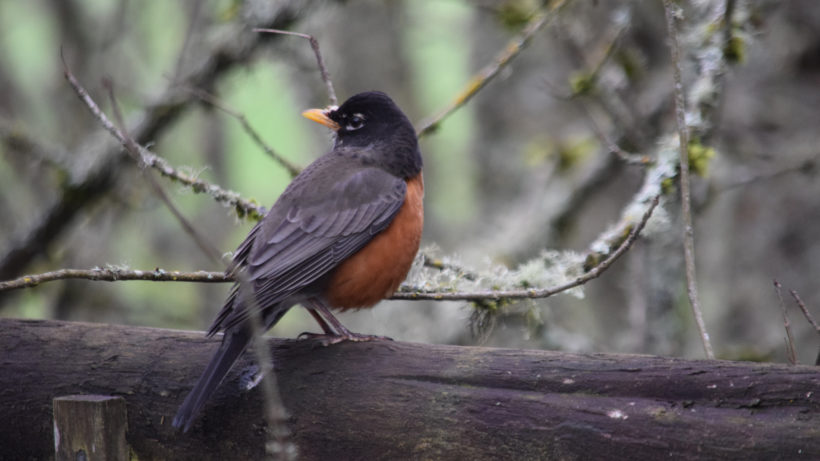
The First Robin of Spring
Robins haven’t been entirely dethroned from their poetic status as spring symbol. Though notions of spring vary by region and temperature. Some robin behaviors take place in step with the warming temperatures that people associate with the arrival of spring.
For instance, as temperatures warm in springtime, the bulk of the robin population follows a more reliable northward spring migration pattern.
“In the spring they migrate with a 36-degree isotherm,” Howard explains. “The ground thaws and that’s when traditional earthworms and some other insect larvae are available. That’s when you see big movements.”
More than anything, the robin’s song remains a reliable indicator that the first wave of spring migration has reached you. This song is one of the first signs that robins are switching from winter behavior to courtship and nesting behavior associated with spring.
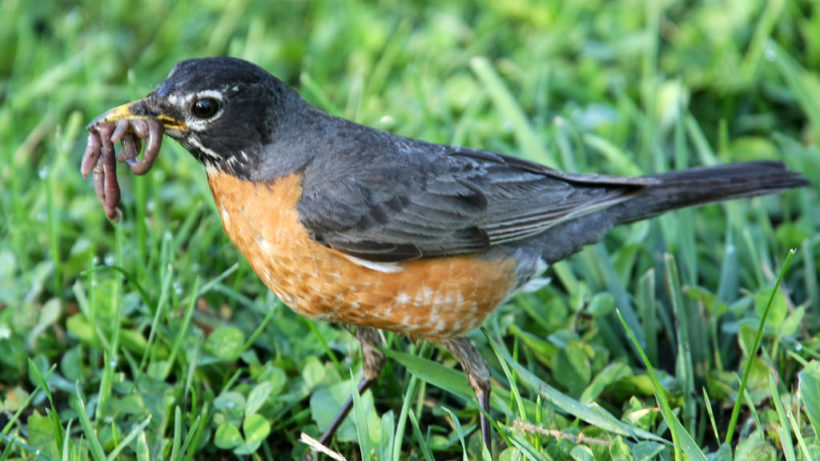
“We see a clear south to north progression in reports of territorial song,” Howard notes. “Across the continent, as males arrive on territory they begin to sing. That true robin song that you hear nonstop all day or certainly through the morning means your local male has arrived.”
Males arrive first to establish their territories – they will fight with their feet to defend them. In spring the males become so territorial that they’ve been known to beat themselves up while trying to fight their own reflection.
“Females arrive a couple of weeks later,” Howard says. “They’re not in a rush. Their job is to have fat stores as plentiful as possible. They don’t want to burn through calories by migrating too early. They need to be in good condition.”
Arriving too early can be bad for reproduction too. A spring freeze can damage the integrity of the nest.
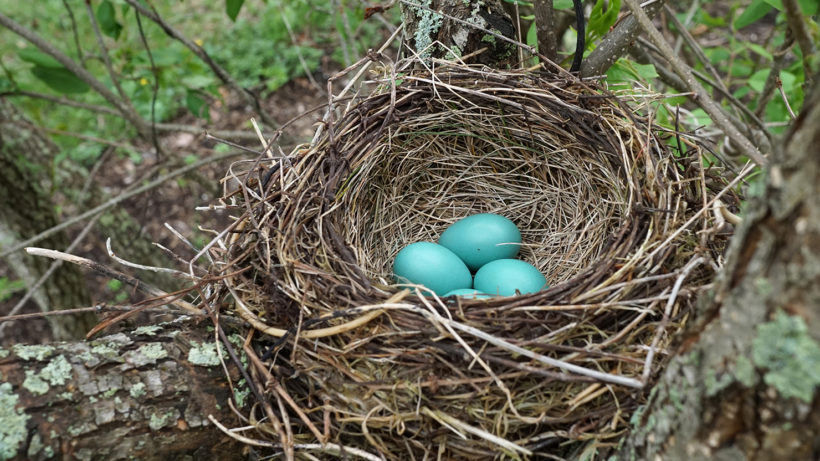
Only the females have a brood patch, an area of warm featherless skin that’s used to transfer body heat to the eggs. Females spend about 50 minutes of every hour on the nest during incubation. It’s two weeks from egg laying to hatching and robins will start a new nest within the month. Robins nest as many as four times each summer, depending on how far north they are.
As in winter, water is one of the best ways to attract robins to your yard in spring.
“If you turn on a sprinkler you’ll have robins within minutes,” Howard says. “It makes the soil soft and earthworms and other food easy to collect.”
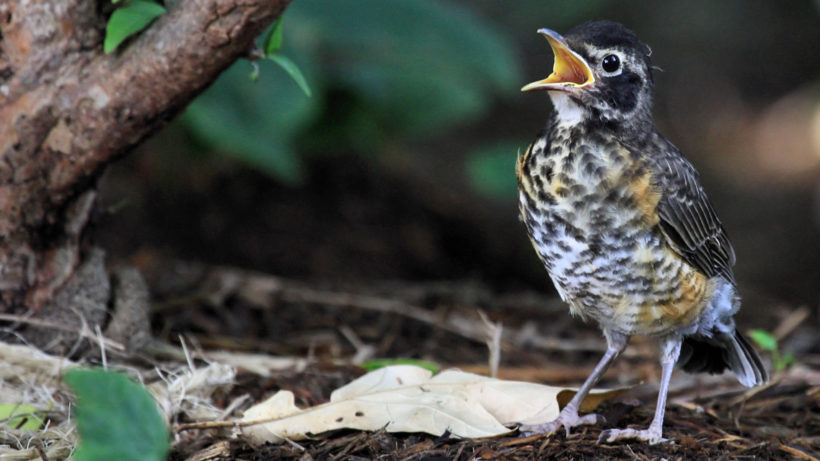
Report Your Robin Observations
You can report robin observations to Journey North all year round. As spring approaches, Journey North has a checklist of robin life cycle events to track and report:
- Over-wintering robins – watch for flocks.
- First male robin – you will know it is a male by his bold red breast and his dark head and back.
- First wave of robins – three or more robins together (but not in the winter) is a sign that migration is peaking.
- Average temperature reaches 36° F – help Journey North find out whether or not this is truly when robins sing.
- First earthworm – help Journey North find out if robin arrival is tied to earthworm availability.
- First robin song – listen for the robin’s true song.
- First female robin – she will look washed out compared to the male.
- First males in battle – they will be fighting over territories.
- Nest building begins – watch for males with a mouthful of nest materials or females with muddy breasts.
- Incubation underway – if you’re not seeing the female around anymore, she’s probably busy incubating.
- Young hatch – watch for adults flying with worms.
- First young fledge – fledglings don’t fly and have a spotted breast. You might see them on the ground or in low branches.
- First young take wing – within a few days of fledging watch for the juveniles to start their practice flights.
- Parents start another nest – when you see the male feeding the fledglings, but the female is absent, she has likely disappeared to incubate a new set of eggs.
“One of the great things about robins is they’re so accessible,” Howard says. “You can look out your window and see them. There’s so much to learn about such an unsung hero.”
Have you noticed unusual robin behavior in your neighborhood or? Share it in the comments and report your sightings to Journey North.
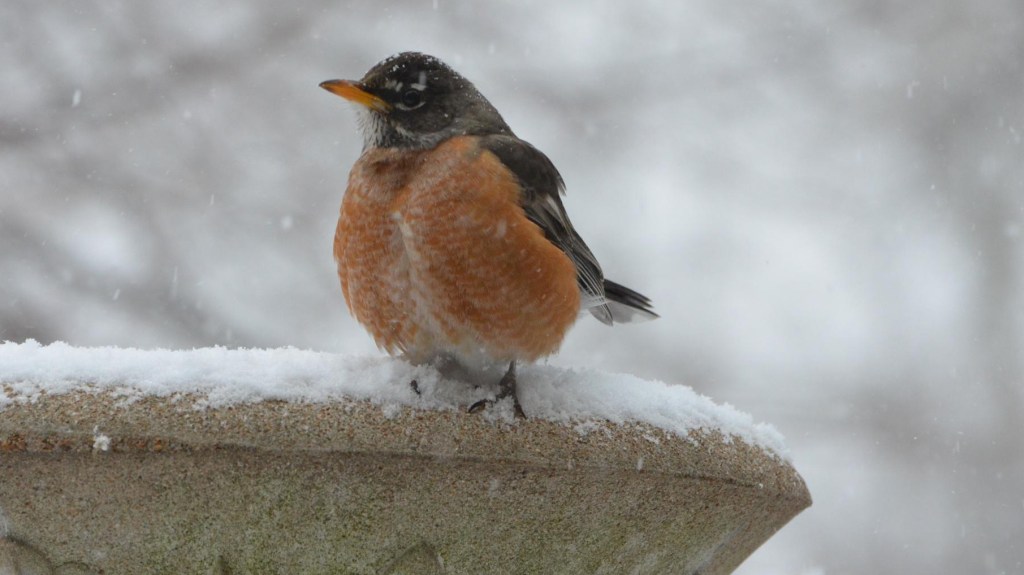



I have had a robin on my window sill for 5 days straight now. I can get very close and it hardly moves. It appears to want to get in the window because it keeps flying into it and leaving marks. Why is it just
Staying here? Is it warmer on the window ledge?
Just saw a flock of about 20 or so robins- all puffed up in the surprise snow we are having in Kingston, NH. Have never seen them in such a group before! Or so rounded! They all flocked to a small flowering tree in the backyard that has old berries on it. They stayed to observe the bird activity at our feeders and then all flew off except for one male and one female who hopped from tree to tree for about 10 minutes.
We have a lone male robin perching for long periods of time on our shepherd hook and also eating from the suet cage.
I’m 73 years old. Today is the first time I ever saw a robin in the winter. It’s very cold out. January in Ohio. I’m pleased to see it. I put out nuts and dried fruit. I read comments and understand this is common. Never too old to learn something new.
We are in the middle of an Arctic Blast and just had a major snow. Yesterday when we got home from church there was a flock of Robin Redbreast on our lawn. It was so weird to see as we usually associate them with the Spring and they never flock. Never in my life and I’m 57.
After we went in we could see shadows across our living room windows, from it being a bright Sunny but cold day. It was these birds ravishing our Holly Bush which has bright red berries and this year an over abundance of them.
They did this over an hour, left fallen berries on the ground everywhere and then pooped all over my brand new Pearl White car I received for Christmas😩.
It was the craziest thing we have seen in our lives. Robin Redbreast has always been a sign of Spring and it’s always one here one there. We are spiritual people. Something different is happening in the earth.
I’m in Troy Mi about 15 miles north of Detroit. Go Lions! I have been watching a robin in my crab apple tree outside my window today and it’s 6degrees F !!! All the birds around it are. Sitting the feeders, but he is just bopping from branch to branch. I first saw him yesterday. In all my life I’ve never seen a robin in these temperatures!
Hi my name is Debbie I live in Middletown ny and it’s January 19th 2024 it is snowing and 26* . I was looking out my window and saw a single robin. We thought that was very unusual
This year 2023-2024 I’ve noticed flocks of 30 or more in tge Chicago suburbs. They didn’t leave for the winter. I feel bad for them because we are in a cold snap with temperatures below zero in January. We have a storm drain in our yard and i see stream rising from tge drain. The robins are sitting on the drain to warm themselves. With temperatures falling to -30 at night i worry about them.
It is December 26th, we are in South Boston, Virginia and have hundreds of robins flying around.
Hi so I came across an American Robin that appears to be a female by the lighter grey color. My two dogs spotted it on our walk. It was jumping only inches high in someone’s front yard and didn’t look too healthy from afar. As I looked closer, it’s left wing was damaged and I could tell it was injured. I gathered him with my sweater and brought him back home to my shed. He has already eaten corn feed and now I gave it sliced apple and he has been drinking and bathing in a bowl of water I left for it in a laundry basket covered with shipping pads so it cannot jump out of the basket, too far from the fruit and water source overnight in 35 degree Fahrenheit weather . I will wait for animal control to come get it the next day. I hope they come for it because I cannot keep it around as a pet as I fully understand it is a wild bird.